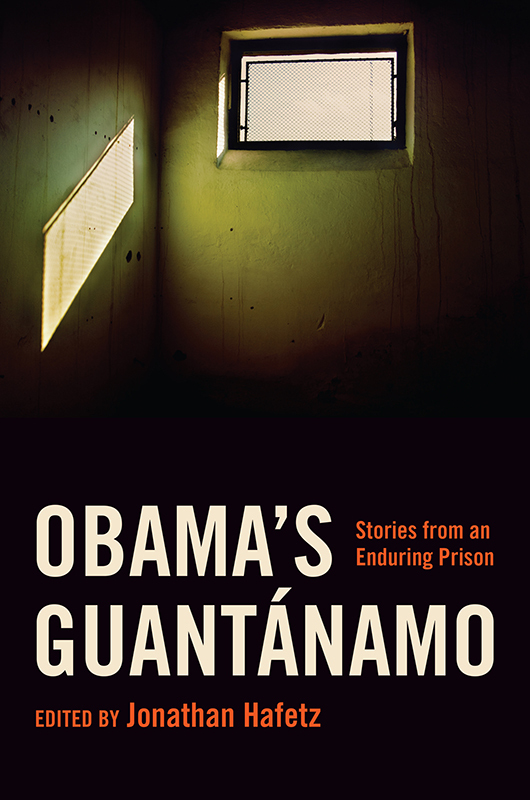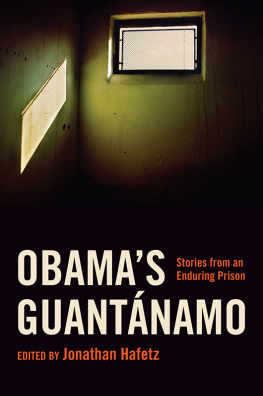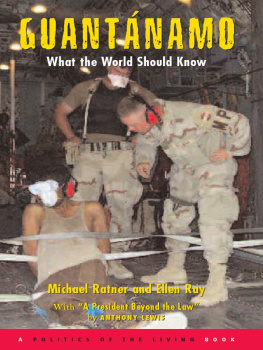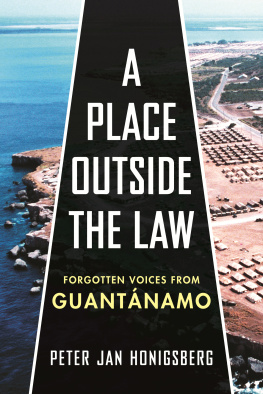
Obamas Guantnamo
Obamas Guantnamo
Stories from an Enduring Prison
Edited by Jonathan Hafetz

NEW YORK UNIVERSITY PRESS
New York
NEW YORK UNIVERSITY PRESS
New York
www.nyupress.org
2016 by New York University
All rights reserved
References to Internet websites (URLs) were accurate at the time of writing. Neither the author nor New York University Press is responsible for URLs that may have expired or changed since the manuscript was prepared.
Library of Congress Cataloging-in-Publication Data
Names: Hafetz, Jonathan, editor.
Title: Obamas Guantnamo : stories from an enduring prison / edited by Jonathan Hafetz.
Description: New York ; London : New York University Press, 2016. | Includes bibliographical references and index.
Identifiers: LCCN 2016001626 | ISBN 9781479852802 (cl : alk. paper) | ISBN 1-4798-5280-5 (cl : alk. paper)
Subjects: LCSH: Prisoners of warLegal status, laws, etc.CubaGuantnamo Bay Naval Base. | Guantnamo Bay Detention Camp. | Detention of personsCubaGuantnamo Bay Naval Base. | Military courtsCubaGuantnamo Bay Naval Base. | Obama, Barack. | Prisoners of warLegal status, laws, etc.United States. | Detention of personsUnited States. | Military courtsUnited States. | LCGFT: Essays.
Classification: LCC KZ6495 .O23 2016 | DDC 344.7303/548dc23
LC record available at http://lccn.loc.gov/2016001626
New York University Press books are printed on acid-free paper, and their binding materials are chosen for strength and durability. We strive to use environmentally responsible suppliers and materials to the greatest extent possible in publishing our books.
Manufactured in the United States of America
10 9 8 7 6 5 4 3 2 1
Also available as an ebook
Contents
Jonathan Hafetz
Sabin Willett
Gary A. Isaac
J. Wells Dixon
Mark Fleming
Pardiss Kebriaei
Shayana Kadidal
Martha Rayner
Alka Pradhan
Omar Farah
Frank Goldsmith
Joseph McMillan
David Frakt
Jason Wright
Aliya Hana Hussain
Jonathan Hafetz
A preceding volume, The Guantnamo Lawyers: Inside a Prison outside the Law, was completed in early 2009, a time of considerable excitement and hope. President Barack Obama, who was just beginning his first term, had ordered the closure of the U.S. detention center at Guantnamo Bay and declared that the United States must respect both its Constitution and international law even when defending its security against terrorist threats. To be sure, difficult questions lingered, including what would happen to the remaining prisoners once the U.S. closed Guantnamo and whether U.S. officials would be held accountable for the past mistreatment of detainees. But at least it seemed that the Guantnamo Bay prison, the overarching symbol of lawlessness and abuse in Americas global war on terror, would be shut and this notorious chapter in American history would come to an end.
Predictions of Guantnamos demise would soon prove premature. Within months, it became clear that Obama would not meet his original pledge of closing the prison within his first year in office. Now, deep into Obamas second term, it seems unlikely that Guantnamo will be closed at any time in the foreseeable future. When Obama took office, 242 prisoners remained at Guantnamo. Today, that number is 107. The drop has been slow, uneven, and arbitrary. Approximately half of those who remain have long been cleared for release by the Obama administration. But most of those cleared detainees are from Yemen, whose security conditions have dissuaded the U.S. from transferring prisoners there. Meanwhile, the legal and political obstacles to closure have become more entrenched. In many respects, the prospect of Guantnamos closure seems as remote now as when the first prisoners were brought there in January 2002. The 9/11 attacks have grown more distant, but Guantnamo remains ever present.
How did we get here? The Guantnamo Lawyers described the Bush administrations creation of a prison beyond the law. Obamas Guantnamo: Stories from an Enduring Prison, recounts the Obama administrations failure to close it. Like its predecessor, Obamas Guantnamo consists of accounts from lawyers who have not only represented Guantnamo detainees, but also served as those detainees principal connection to the outside world. The lawyers poignantly describe their clients plights and deepening sense of despair. In many respects, the landscape has become increasingly difficult to navigate. Lawyers and their clients face a relentlessly hostile legislative branch, a judiciary that has become less receptive to their claims, and an administration that refuses to expend the political capital necessary to close the prison.
The seeds of failure were sown from the beginning of Obamas presidency. After ordering Guantnamos closure, Obama created a task force to study what to do with the remaining prisoners rather than immediately taking action. In 2015, Obama himself would recognize this as a mistake, acknowledging that he should have closed Guantnamo on his first day in office. As opposition grew during his first year, Obama proved weak and indecisive. Two critical missteps stand out. First, in the spring of 2009, Obama abandoned his plan to resettle detainees in the United States, a move that, if taken, would have transformed the political landscape around Guantnamo. The first detainees slated for resettlement in the U.S. were ideal candidates: a handful of Uyghurs, a minority group from northwestern China, who by all accounts posed no threat to the U.S. and never should have been detained in the first place. The Uyghurs could not be returned to China because of the risk of persecution there, thus making their resettlement in another country essential. But Obama caved at the first sign of resistance, fearful that he would be painted as soft on terrorism. Abandoning the plan to bring the Uyghurs to the United States not only revealed that Obama lacked resolve on Guantnamo, but also discouraged other countries, in Europe and elsewhere, from doing more to resettle detainees. Because the U.S. was unwilling to help clean up its own mess, other nations felt less compelled to come to its rescue.
The second critical mistake was maintaining the legal architecture supporting Guantnamo. In a May 2009 speech at the National Archives, Obama indicated that he would seek to prop up military commissions, the discredited tribunals established by President Bush to try terrorism suspects of largely made-up war crimes in violation of domestic and international standards of justice. Rather than scrap military commissions, Obama tried to reform a system that was beyond repair, breathing new life into Guantnamo. Obama also adopted the Bush administrations position that the president had the authority to continue detaining individuals indefinitely without trial under the Authorization for Use of Military Force (AUMF) on the theory the U.S. was engaged in a global armed conflict against Al Qaeda and associated terrorist organizations and those individuals at one time were part of or had supported those groups. Without that authority, the legal basis for Guantnamo would have collapsed; with it, Obama could maintain that detentions at Guantnamo were lawful as long as the war continued, however undesirable as a matter of policy.
As Obama wavered, the backlash against closing Guantnamo grew fiercer and the politics more toxic. By the end of 2009, Congress began restricting Obamas ability to move prisoners from Guantnamo. Initially, Congress barred bringing detainees to the United States, not merely for release, but also for continued detention or prosecution. It then limited Obamas ability to send detainees to other countries by imposing unprecedented restrictions on the commander-in-chiefs authority to transfer wartime prisoners. Although Obama protested, he always acquiesced. Obama, moreover, failed to use aggressively the limited authority Congress had left him to transfer prisoners. Between early 2011 and mid-2013, the transfer of prisoners from Guantnamo came to a virtual halt. In January 2013, the administration shut down the one office dedicated exclusively to closing the prison. As the chasm grew between Obamas postinaugural promise and the reality of the prisons continued existence, it became difficult to remember that the presidential candidates from both parties had previously supported shutting the prison. Closing Guantnamo had gone from a bipartisan issue to the new third rail of American politics.
Next page






